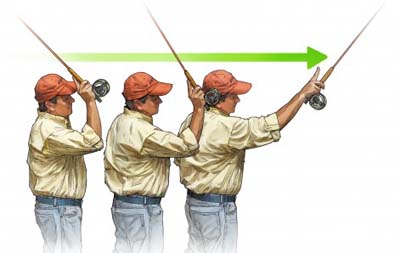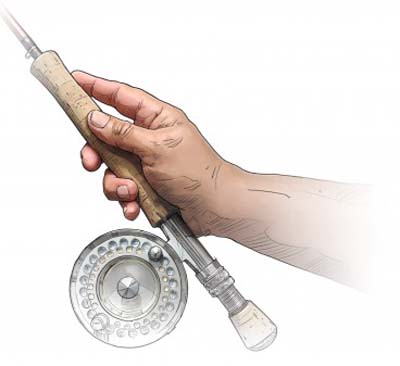If you have an interest in improving your game, try the Mahler Method
Until you get past switch rod length, using the index finger as your casting trigger improves casting distance and accuracy, and automatically eliminates wrist-hinge; the dread disease of the beginner and dedicated bad caster.
Change pitchers
There’s barley measurable time needed to make the switch to successfully using the Mahler method. Me, 20 minutes, but that was with Mahler at the podium. It was the nuance of starting the rod tip low (water level) and coming up slowly, letting the rod load at a 45 degree, or more angle, that took muscle memory time to get lost. Overcoming that parallel to the ground plane still creeps into my game sometimes. The forward cast doesn’t require relearning, but there, too, a few nuances learned better your performance on both distance and accuracy – read on.
There will always be deniers
Deniers, of course, have a lot to say about why it doesn’t work. For example: “Above a 6-weight, and especially weights like 10 up, the index finger could be permanantly damaged or even broken.” That was from a pedegreed casting Instructor at a Low Country Expo last spring. I haven’t found his claims to be true and the instructor was reportedly not an Orthopedic Hand Surgeon. Contrarily, I found the opposite true. I’m comfortable with an overhand Mahler Technique cast using my 10-foot/6-inch, 8-weight switch rod on surf trips to South Florida.
With permission, we are re-posting Joe Mahler’s Sage blog piece including his illustrations.
Is it time for a Grip Switch?
by Joe Mahler
[dropcap]W[/dropcap]hen the subject of grip comes up and I express that I prefer the Index on top, the response is usually something like, “I can see using that for little short casts” followed by a schoolmarm-like finger pointing motion. But you might be surprised to find that, when done properly, the index on top grip offers the same power with less effort expended by the caster, than the Thumb on top or the V-grip. The thumb on top is, I believe, the most popular grip used today, so I will use it for comparison in this article.
The index finger on top is a cornerstone of my casting style. I use it when fishing, because it is efficient. I use it in teaching because it makes my job easier and accelerates the learning process. It makes sense to me. As I see it, there are four major reasons for choosing this grip and here they are in order of importance.
 Leverage
Leverage
As you know, the rod is a lever. Think of the hand as the lever that works the lever. Comparing the two grips, you will notice that the index finger extends considerably further up the cork than the thumb. Simply put, the longer the lever, less is the effort required to operate it. I have been told that the thumb is stronger than the index finger and I don’t doubt it. But with the added leverage of the index finger, strength is no longer the issue. The key to getting the most from this grip is to apply the power with the finger tip. People are often surprised to find that I use this grip when using 10 or 12 weight rods, but there is no reason to change grip with equipment and the added ease of casting is especially noticeable with heavier rods.
The Stop
The back cast is the foundation of the fly cast. If the back cast doesn’t straighten behind the caster, problems occur. Usually, the cause isn’t lack of power, but rather a failure to stop the rod firmly without allowing the rod tip to travel too far back. If you were to form an imaginary pistol with your casting hand and raise it so your finger is pointing skyward, you’d notice that the thumb is pointing back in a horizontal position. The index on top provides a naturally correct stopping point for the back cast. In fact, it is difficult to go too far back using this grip.
Attitude
Perhaps the most significant difference in the two grips is the attitude or position of the hand, wrist and forearm during the cast. With the thumb on top, the hand and arm are raised and lowered in the same manner that one would use to drive a hammer or chop with a hatchet.
When the index finger is placed on top, the hand, wrist and forearm flatten – as if to push a door open. This motion encourages the caster to continue the stroke forward, stopping the hand at eye-level, rather than driving it downward.
 Accuracy
Accuracy
For the same reason that it is easier to be more accurate with a rifle than a pistol, I believe it is easier to hit a target with the index on top. I favor a more vertical cast than many, and find that when I point the end of my index finger (not the rod tip) at the target I get a more accurate cast than with the shorter thumb. An unwanted curve in the layout – especially at longer distances – can oftentimes be eliminated instantly, simply by switching to the index on top grip, as straight tracking seems easier to achieve.
In addition to the above reasons for choosing the index on top, there is one more subtle point I will offer. As you sit reading this article, reach over and feel the surface of the table, desk or chair. My guess is that you used your fingertips – not your thumb. As humans, we are conditioned to feel with our fingertips and I always encourage students to cast with a loose grip relying on feel. In fact, one exercise that I use frequently is to have the students close their eyes and cast. In most instances, there is no difference between the eyes open and the eyes closed cast. I believe that the feeling in the index finger is keener and sends a sharper signal.
 Try it for yourself
Try it for yourself
Here is a quick tip for the index on top grip. Start by loosely gripping the rod slightly closer toward the butt than normal – I like to place the heel of my hand on the reel seat itself. Pretend that there is a button precisely at the point where the tip of the index finger contacts the cork. Make sure that the fingertip is the only part of the finger that touches the cork. Make your pick-up by placing the rod tip low and applying pressure with the inside of the middle finger to make the back cast, stopping the rod firmly with the index. Now, smoothly move the rod forward in a straight line and in the middle of the stroke, push that imaginary button with your fingertip and let off. I think that you will find that the power delivered by that simple push is sufficient to unroll the fly line and straighten the leader.
Sage Ambassador Joe Mahler lives and teaches fly casting in the Sanibel / Fort Myers, Florida area. Joe is also a frequent contributor to Fly Fisherman Magazine. You can contact him here . . .
[information] You can also access information about an upcoming winter trip to the Bahamas that Joe Mahler and Drew Chicone are hosting . . .
[/information]



